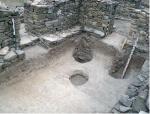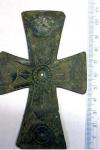Summary (English)
HOTALICH FORTRESS (Nadezhda Boteva – nadejda_boteva@abv.bg) Three churches were situated on the slope below the fortress. In 1979 and 1980, two of them were partly explored and 60 graves of the 9th – 14th centuries were excavated in a cemetery located close to the churches. In 2012, the two churches were thoroughly explored. Church No. 1 was single-apse, 23.60 m by 9.20 m in size, with walls 70 – 80 cm wide, built of roughly-cut stones bonded with mud. There was a second wall, parallel to the western wall of the nave and located at 60 – 70 cm from it, probably a foundation of a colonnade. Later on, a narthex was added, 4.30 m by 9.20 m in size and with two entrances from the north and the south. The church was decorated with frescoes and was probably built in the 12th century. Judging from the coins discovered, it was burned in the middle of the 13th century. A workshop was set up in the church interior, after the fire. A hearth was discovered, with a layer of ash, charcoal, slag and sherds of the 13th century. Three midden pits were discovered, containing fragments from frescoes, burned timber, nails, an arrowhead, a jewel, coins from the end of the 11th – beginning of the 12th centuries, a bronze procession cross of the 10th – 11th century and sherds of the 13th century. Church No. 2 was single-nave and single-apse, 12.90 m by 5.60 m in size. The narthex was 4 m by 2.60 m in size. The church was built within the nave of Church No. 1. Its walls were 75 – 80 cm wide, constructed of roughly-cut stones bonded with mud. Eight copper coins of 1225 – 1250 and sherds of the 13th century were found. The church was built at the end of the 13th – beginning of the 14th century and was reconstructed through the 15th – 16th centuries. There was a room, 2.60 m by 2.10 m in size, located at the southeastern corner of the church. Two burials were discovered. Grave No. 61 belonged to an adult. A cross-encolpion, showing the Crucifixion of Christ and St. Mary Oranta, was found on the chest of the deceased. Grave No. 62 belonged to an adult. Three coins of the 1220s – 1230s were found in the grave.
- Nadezhda Boteva - Museum of History – Sevlievo
Director
Team
Research Body
- Museum of History – Sevlievo






![Download [PDF]](/excavation/skins/fasti/images/results/download_sml.png)

